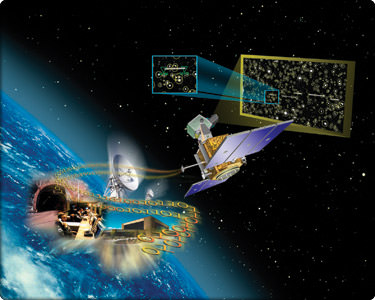Work is currently underway to construct a space surveillance and tracking system that will keep watch over objects in orbit around the Earth. This project, known as the Space Based Surveillance System (SBSS), is designed to protect satellites from damage by space debris - or from military attack.
Why Do We Need It?
During the last half-century, the modern world has become increasingly dependent on artificial satellites. We now rely on satellites to predict the weather, connect our telephone calls, and beam television signals into our homes. Military satellites play a vital role in supporting troops on the ground by providing precise information about the movements of supplies, vehicles, and enemy troops. The GPS (Global Positioning System) technology that makes this possible is now in widespread commercial use, helping drivers to find their way and smartphone users to access a wealth of local information at the touch of a button.
Damage to any one of these satellites would deliver a costly blow to communication infrastructure, military capabilities, or geolocation technology. Another potential catastrophe is the possibility of damage to the International Space Station (ISS), a vast space based research facility, which cost approximately $100 billion and currently houses six crew members.
Yet despite the crucial role that they play, both satellites and the ISS occupy a very vulnerable position. Outside of the protective cover of the Earth's atmosphere, they are susceptible to collisions with meteorites. In addition to natural objects, the area around the Earth is littered with 'space debris': man-made debris that has been left behind by past space missions. The new surveillance system will track the paths of orbiting objects so that satellites can use their boosters to move out of harm's way.
In addition to maintaining the smooth flow of traffic around the Earth, SBSS will also be on the look out for potential military threats to U.S. satellites. The U.S. military's GPS is vital for the control of their precision attack missiles. If the GPS satellites were taken out of action by a surprise attack, that could make it much more difficult for the U.S. to co-ordinate a precision retaliation. This new system has been commissioned by the U.S. Department of Defense to help it protect the space based assets of the country and its allies.
How Will It Work?
The Space Based Surveillance System will use satellites and ground-based controllers to monitor objects in space. The first satellite was launched in September 2010. Onboard the spacecraft are a gimballed camera, which can be turned to look in different directions, a reprogrammable processor, and solar panels to power the onboard equipment. The satellite has been sending back signals which suggest that it is operating as planned.
The advantage that a space based system has over a ground-based space surveillance and tracking system is that it is not subject to interference from the weather or other atmospheric effects. It is estimated that the accuracy with which objects' positions are tracked will be increased by a factor of ten by the introduction of the new system. In addition, a network of satellites can survey a larger area of sky than telescopes on the ground. A ground based telescope can only survey the area directly above it, whereas from their vantage point high above the Earth's atmosphere, surveillance satellites have a much broader field of vision.
SBSS will replace the current space surveillance and tracking system, which is known as the MSX/SBV (Mid-Course Space Experiment/ Space-Based Visible) system. The existing MSX/SBV system was constructed in the 1990s. Although it succeeded in reducing by half the number of objects lost in orbit, most of its sensors have now failed. An updated system is badly needed.
Progress So Far and Future Development
The plan to construct a space surveillance and tracking system was drawn up following a commission carried out in 2001, which reported on the risk of a space-based "Pearl Harbor" scenario. There was a fear that U.S. satellites could be vulnerable to surprise attacks. The commission was headed by Donald Rumsfeld, who was the U.S. Defense Secretary at the time.
A number of contractors are currently working to build the infrastructure needed to operate the system. The main contractor, Boeing, built the satellite that was launched in September 2010, in partnership with other contractors, Ball Aerospace and Harris Technologies. The rocket that launched the satellite into space was a Minotaur IV rocket produced by Orbital Sciences. This satellite, known as the Block 10 SBSS Pathfinder satellite, is expected to eventually form part of a system of satellites that will all play their own role in tracking and monitoring objects in orbit around the Earth.
The next stage of development is the construction and deployment of four more satellites, known as the Block 20 SBSS satellites. These will expand the system's capacity for observing the full orbital region. The full system is scheduled to be completed in 2013.
Article Source: http://EzineArticles.com/?expert=Sylvia_Jack




Would love to here from you...